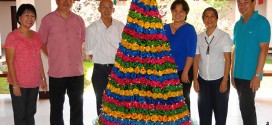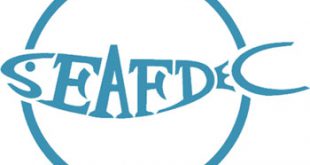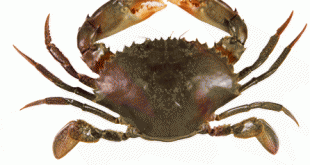Images featuring AQD's Christmas 2012 celebration
Read More »Webmaster
New agreement with the private sector
SEAFDEC/AQD signed an agreement with Hong Kong-based Kiko Technology for a test trial of their new product called Tritan (designed to improve water quality). The signing was held on 16 January at AQD’s main station in Tigbauan, Iloilo, Philippines.
Read More »AQD gives update on freshwater prawn
SEAFDEC/AQD scientist Dr. Ma. Lourdes Aralar was invited by the Southern Leyte State University (SLSU) - Bontoc Campus to be a plenary speaker in the First international giant freshwater prawn congress held 9-11 January in Southern Leyte, Philippines.
Read More »AQD welcomes intern and student vets
The new year brings new learners to SEAFDEC/AQD. The first is Mr. Benny Lim, a college student from Brunei Darussalam studying in Winchester, United Kingdom and 12 graduating students from the School of Veterinary Medicine of Aklan State University (ASU).
Read More »At the fair: AQD serves stakeholders
SEAFDEC/AQD’s research-and-development work was promoted during the 5th Aquatic fair and bazaar held 7-9 December 2012 in Quezon City, Philippines.
Read More »Pens
Mud crabs can be grown in pens installed in existing mangroves for up to 3 months. The pen can be rectangular, square or irregular shape and the size ranges from 500-1,000 m2. The use of net enclosures in mangroves offers an alternative to pond culture. It also promotes a better image for brackishwater aquaculture that had been linked to the historical clear-cutting of mangroves to make way to ponds. Lean crabs may also be fattened using pens set in mangroves within 30-45 days. Mud crab pen culture is recommended in sites with mature mangrove trees in lower part of the intertidal zone. Procedure: Enclose the selected area with bamboo slats or nets (durable enough that cannot be destroyed by crabs) …
Read More »Grow-out
Crabs are commonly cultured with fish in earthen brackishwater pond. Cannibalism in crabs is reduced by lowering the stocking density and maximizing the space by stocking fish. Common combination of crab is milkfish. Crabs (15 g to 30 g) are stocked in the pond with fish and grown for 3 to 5 months. The culture period depends on the initial size of crabs and fish and the stocking density. Two or more crops may be done in a year, depending on the desired crab size at harvest. Procedure: Prepare pond using standard procedure. Grow natural food such as ‘lablab’, plankton and other natural food prior to stocking. Stock milkfish fingerlings at 2,000-3,000/ha and crab juveniles at 500-800/ha. Acclimate animals to …
Read More »Nursery
Nursery is the intermediate phase between hatchery and grow-out. Crabs with 0.6-1.0 cm carapace width (CW) (Fig. 1) are cultured to 1.5-2.0 cm CW in net cages installed inside the pond (Fig. 2), in a pond fenced/lined with nets (Fig. 3), or in a pond provided with net fence along the dikes (Fig. 4). Some farmers prefer bigger crabs than 1.5-2.0 cm for stocking so crabs are further grown to 3.0-4.0 cm (Fig. 5) in ponds lined or fenced with nets or dikes installed with net fence (Phase 2) prior to stocking in grow-out ponds. Phase 1 and 2 may be done one after the other separately or continuously using the same pond compartment. The culture period is 3-4 weeks …
Read More »Hatchery
Although the technology applies to all the three species of mud crab (Scylla serrata, S. tranquebarica, and S. olivacea) available in the Philippines, S. serrata or the giant/king crab has been the focus of culture in the hatchery/nursery and grow-out pond due to its economic viability. Procedure: Obtain healthy adult crabs 500-700 g for S. serrata and 320-500 g for S. tranquebarica and S. olivacea with orange ovaries (‘aligi’) and complete legs as source of broodstock from ponds or traders. Put crabs in an empty basin and pour seawater over them slowly. Transfer crabs to basin containing 150 ppm formalin for 30 minutes to disinfect. Transfer crabs in tanks provided with sand substrate. Feed crabs with mussel, fish and/or marine …
Read More »Mangrove crab (Mud crab)
Why mangrove crab culture? High demand in local and export markets Large and good taste Polyculture with milkfsh, tilapia or siganids Easy to transport Culture in mangroves Investment for people’s cooperatives and fisherfolk organizations with tenure of mangrove area SEAFDEC/AQD’s work on mangrove crab Studies on mangrove crab at the SEAFDEC/AQD started in 1977, but were soon discontinued to give way to a priority shrimp species, Penaeus monodon. Studies were resumed in 1997 in collaboration with Australian Centre for International Agricultural Research (ACIAR) mainly to develop …
Read More »Mail from a Cambodian trainee
Addressed to scientist-trainors Dr. EG de Jesus-Ayson, Dr. RM Coloso and Dr. MR Catacutan on the AQD course conducted 3-7 December, a trainee from Cambodia express his gratitude to AQD by sending a message through e-mail.
Read More »“I challenge AQD to maintain its leadership” – Sec Gen
SEAFDEC Secretary General Dr. Chumnarn Pongsri and four other senior Secretariat officials came for a three-day visit to AQD from 11 to 13 December and fielded questions during a general assembly of staff on 12 Dec at AQD’s main station in Iloilo.
Read More »AQD presents its programs at the 35th PCM
Over 50 participants gathered in ChiangMai, Thailand from 26 to 30 November for the 35th Meeting of the Program Committee (PCM) of SEAFDEC and the 15th Meeting of the Fisheries Consultative Group/ASEAN-SEAFDEC Strategic Partnership (FCG-ASSP).
Read More »AQD hosts demo-workshop on library software
AQD hosted the “Demo-workshop on the KOHA integrated library system” held 10-11 December in Tigbauan, Iloilo. The 34 participants were from public secondary schools and libraries in Western Visayas; and the resource persons from the National Library of the Philippines. Topics included software modules on cataloguing, readers’ services, field service scheduling software, serials management, acquisitions and library administration. The demo-workshop was funded by the National Commission for Culture & the Arts (National Committee on Libraries & Information Services) and organized by the Philippine Librarians Association Inc (Region VI Council).
Read More »International seminar on stock enhancement
SEAFDEC/AQD and the Government of Japan Trust Fund (GOJ-TF) conducted the “International seminar on environment - friendly aquaculture and stock enhancement in Southeast Asia” on 3 December at AQD’s main station in Tigbauan, Iloilo, Philippines.
Read More »Aquaculture for communities
Seven participants from Cambodia (1), Malaysia (1), Thailand (1), Vietnam (1), India (1), and the Philippines (2) completed SEAFDEC/AQD’s training course on “Community-based freshwater aquaculture for remote rural areas of Southeast Asia” that was held 26 November - 5 December at AQD’s station in Binangonan, Rizal, Philippines.
Read More »LGU Misamis Oriental visits
On 28 - 29 November, six officials from the local government unit (LGU) of Misamis Oriental toured SEAFDEC/AQD’s hatcheries and visited AQD’s station in Dumangas, Iloilo, Philippines. They also went to a mud crab fattening farm in Roxas City, Capiz.
Read More »6th National Malacological Convention
15-19 December 2012 | SEAFDEC/AQD FishWorld, Tigbauan, Iloilo, Philippines | Organized by The Malacological Society of the Philippines, Inc. and SEAFDEC/AQD
Courses on food safety and land evaluation for fishpond development
AQD conducted an International training on food safety of aquaculture products which was held 12 - 16 November and a Training on conducting inventory and evaluation of public lands released for fishpond development purposes held 11-16 November at SEAFDEC/AQD’s main station in Iloilo, Philippines.
Read More »AQD co-organizes biotech forum
Disseminating the benefits of biotechnology and mobilizing advocates were the main focus of the Scientific forum on biotechnology for communicators held 15 November at Iloilo City, Philippines.
Read More » SEAFDEC/AQD Southeast Asian Fisheries Development Center | Aquaculture Department
SEAFDEC/AQD Southeast Asian Fisheries Development Center | Aquaculture Department



